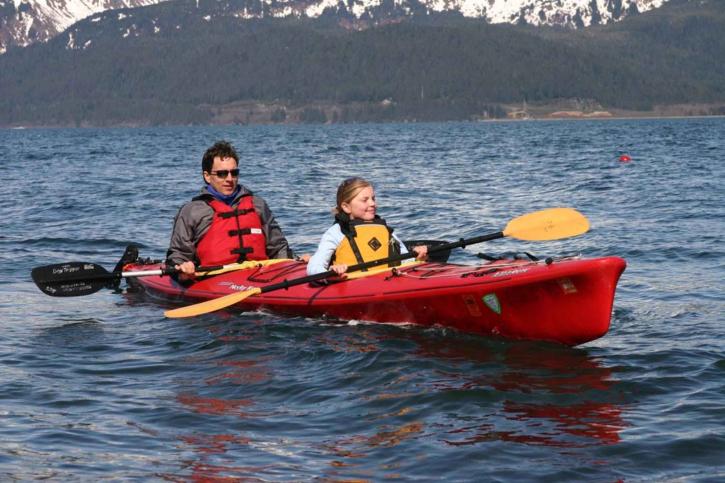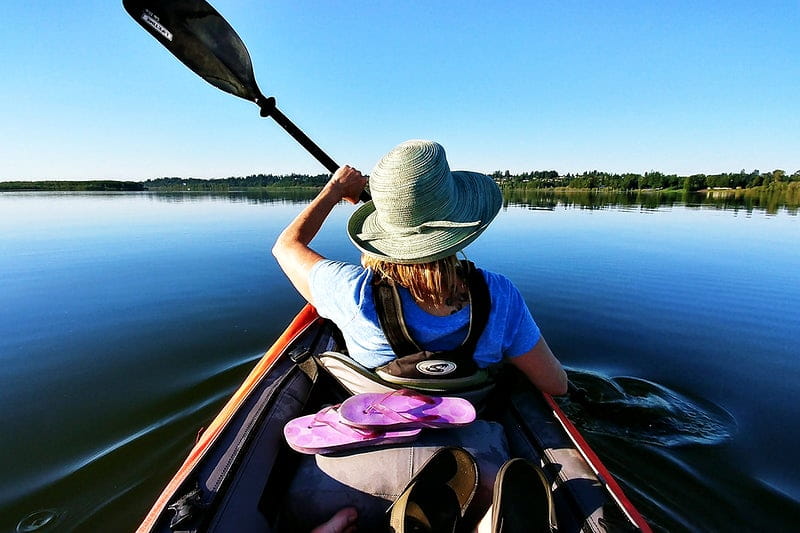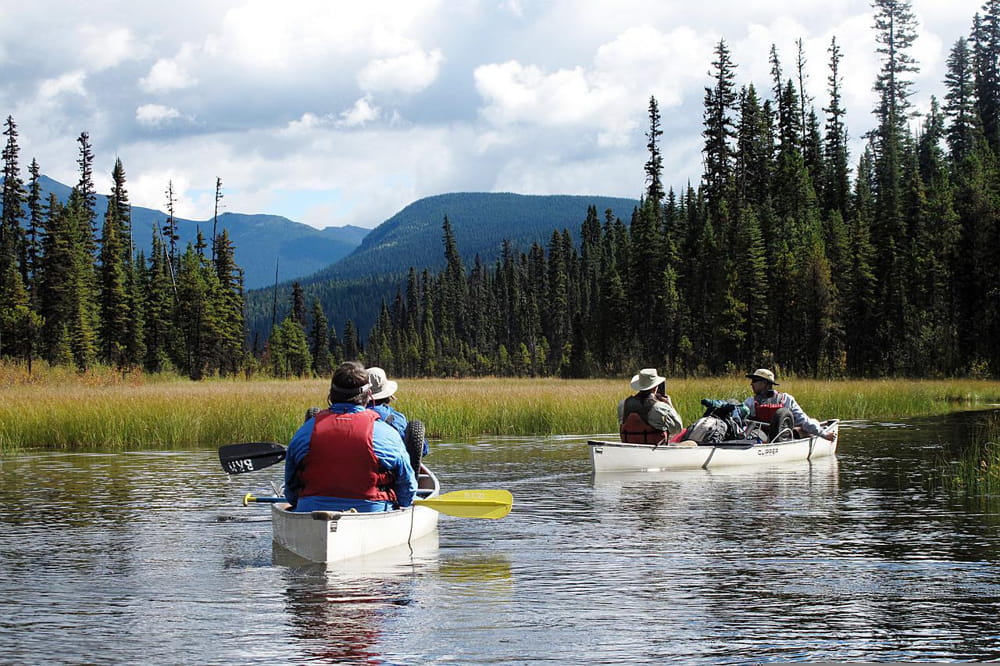Boat flipping is the last thing you want to happen on your excursion. Then you may wonder: Which is easier to flip, canoe or kayak?
This question is crucial because it helps you learn boating safety tips and expect risks. So, to assist you in preparing for your next boating, we’ve gathered everything you need to know about boat flipping in this article. Let’s check!

Which Is Easier To Flip, Canoe Or Kayak?
You may accidentally flip both kayaks and canoes. However, canoes are more stable, reducing the risks of flipping.
Regarding boats, there are two levels of stability to consider.
Primary stability
The primary stability of a boat is its capacity to ensure stability in the water under usual conditions. So how can we tell the usual condition? There are some criteria for it:
- The boaters sit up straight and paddle as normal.
- No exceptional situations are affecting the boats negatively.
- The water is calm, and passengers stay stable and predictable.
Canoes win over kayaks here. They have more of their hull underneath the waterline despite sitting higher. They are, therefore, fairly good in terms of primary stability. In comparison, a kayak is frequently narrower and comes with more rocker.
The curved hull of a kayak makes it easy for the bow and rear to float higher. This structure increases the maneuverability and speed of boats at the sacrifice of stability.
Secondary stability
Secondary stability occurs under duress. For example, if you lean over one side or the water becomes rough, the secondary stability keeps your boat from rolling.
This feature is essential for kayaks. Although it varies depending on design, kayaks offer better stability in this term.
Please note that you need to check for the model you buy to ensure this level of stability. Often, rounded hulls give superior secondary stability, but most canoes and kayaks have flat bottoms.

Which Kayaks Flip Most Easily?
There are two ways to classify kayaks. Based on the design, you can find sit-in, sit-on, hard-shell, and inflatable kayaks. And based on purpose, we have fishing, whitewater, recreational, touring, and racing kayaks.
Sit-in kayaks are more stable than sit-on models. Fishing and recreational kayaks often have good stability. Some models even let you stand up without tipping.
Touring and sea kayaks are less stable despite their enormous size. You can reduce the risk of flipping by handling the boats with caution.
Whitewater kayaks are the most likely to turn over. They focus on maximizing maneuverability instead of working on stability. Moreover, these models are usually short, offering them less power to cope with swells and waves.
Racing kayaks boost speed. Hence, they are also unstable. These boats are better at handling flat water than the rough ones. They also have a pronounced rocker that decreases the stability.
Which Canoes Flip Most Easily?
Canoes are not as easy to flip as kayaks. They are more stable because they are wider and have a more balanced load distribution.
There are three types of canoes: whitewater, recreational, and racing canoes. The width affects how stable the boat is when moving in the water.
Recreational canoes are the most stable option because they aim for beginners and often move more slowly.
On the other hand, racing canoes and whitewater canoes aim for maneuverability and speed. The whitewater models come with more rocker to steer easier, making them the least stable.

Tips To Avoid Canoes And Kayaks From Tipping
How you paddle and what you pack affect how safe your trip is. The following tips explain why such things matter and help you deal with them.
Sit in the right spot
The passenger who weighs the most should sit in the middle of the canoe since that is the most secure position.
The front paddler steers while the back paddler regulates speed. It also aids in maneuvering rapids in tight areas.
If there are three people on a kayak, the heaviest one should sit in the middle to achieve balance for the boat.
The person at the back of a boat should sit up straight and stroke more strongly if you wish to move forward more quickly. This person should lean towards the direction your team wants to travel to turn the boat.
While a back boater uses a heavier stroke, the front one should use a moderate, steady stroke. Then, you can handle tight passages and rapids with less difficulty.
Travel on calm water
Your boat will be more secure and stable if you paddle on a river or lake with calm waters. Such conditions do not pose any pressure to cause instability.
Boats, mainly canoes and kayaks, are at risk due to severe winds and waves on the water. They fluctuate, which makes them unsafe.
Therefore, your boat can be much more likely to flip if you’re sailing on a river with waves than it would be if you were on a calm lake.
Reduce weight on the boat
If a boat is carrying much weight, it will tip more easily. Even the most skilled kayaking techniques can’t help in this case. If you have to bring more stuff, consider a boat with a higher capacity.
Often, you may have to quit some gear like fishing rods or cameras to reduce the weight while boating. Learn the fundamentals of kayaking to determine how much burden you can take.
Ensure your kayak is safe for passengers and the equipment you bring on board before adding any accessories or taking anyone on an excursion.
Extra tips
If you’re anxious that your kayak or canoe will tip over, keep in mind these pieces of advice from seasoned paddlers:
- Select your boat based on your paddling style, the type of kayaking you want to undertake, and your skill level.
- Do not go too low or too high.
- There ought to be three contact points at all times.
- It would help if you always let your paddle work at all times.
- Just make sure you’re comfortable and stay balanced.
What Should I Do If I Flip My Kayak/Canoe?
Do not panic when this accident happens to you. Take a deep breath and follow this guide:
Protect your items
Make sure to secure your belongings on the boat first. It implies that if you accidentally capsize, everything should remain on the ship rather than diving to the water’s bottom.
In addition, put some objects in waterproof boxes or bags so they won’t get wet even if you drop the packet.
In case anything goes wrong, keeping your dry clothes and emergency supplies, such as first aid kits, food, and a cellphone, kept in a watertight container is an excellent idea.
Hold on to your paddles
Before doing anything when you get stuck in the water, grasp onto the paddle and hold it firmly. Losing the paddle is not the worst scenario, but it’s hard to find the paddle and travel back to the land without it.
Get back to the boat
The next problem is reentering the boat. Sit-on-top kayaks are very simple to flip over while paddling, but sit-in boats might be more tricky.
Although you will need to turn them over gently, the accident usually pours some water into the boat cockpit.
You must tip your boat in your direction to drain the most water out. You can’t get it all out, so don’t stress. Just move far enough to let you return to land.
Depending on the type of canoe and the number of passengers, there are different ways to get back to your boat.
A sit-in boat can be more challenging to re-board than a sit-on one. It would be best to learn from experts about how to do it before you go boating.
Conclusion
Kayaks are easier to tip than canoes because canoes have wider hulls. However, it may also depend on the model you boat with.
Boat flipping is not the end of the world. You can follow our instructions to return to your boat and the land.
Flipping is an accident, so be prepared and learn how to deal with it properly before heading to the water. Thank you for reading!